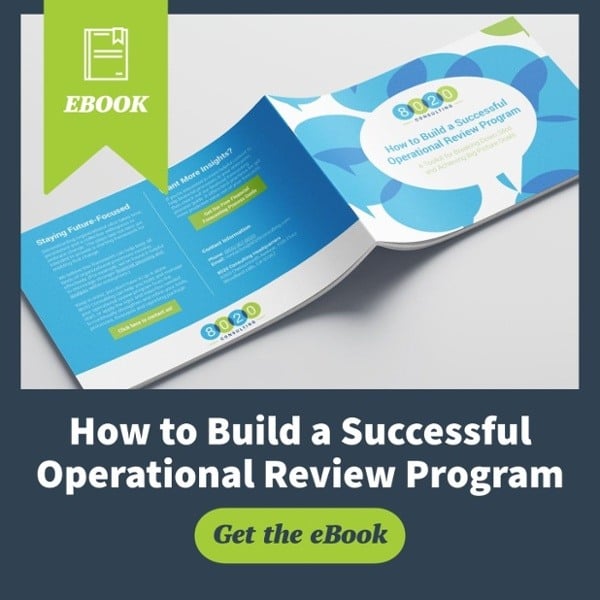
When thinking of Finance and Operations, envision two sides of the same coin. Operations executes the company mission and strategic goals while consistently adapting to ever-changing global dynamics. Finance assures resources are allocated properly to these same strategic goals, while working as the gatekeepers of the organization’s financial health. These two departments are more interrelated and interdependent than many companies realize – and understanding how the two areas work in tandem can yield great efficiencies and benefits.
Common Gaps Between Finance and Operations
In most high-growth and startup companies, the Operations department is ambiguous, nonexistent or embedded into multiple departments such as Sales, IT and even Finance. This way of running a business becomes unsustainable in the long run, as lines are blurred, and conflicting priorities arise.
I’ve seen companies in the high-growth/startup phase where all departments are focused purely on driving revenue. Initially, companies can get away with only top-line focus. However, as business scales and without dedicated teams focusing on operational discipline, the profit starts to suffer. When the lightbulb moment to bring operational focus inevitably happens, the companies have to undergo substantial restructuring to mitigate.
Mature companies can have extensive Operations departments, but often they are quite siloed from Finance, which can create misalignment. For example, it’s common for Finance to only become aware of operational obstacles after the fact – specifically when Operations uses those obstacles as justifications for underperformance in variance reporting. In more aligned circumstances, Finance and Operations will work together in solving various issues as they happen and bring awareness to the key stakeholders.
A good leadership team will focus on creating a culture where partnership is encouraged between these two complementary areas. Finance has a first-hand view of the company’s “report card” (i.e., financial statement) and knowledge of what areas need attention for improvement, and Operations can provide in-depth reasoning behind the data. Both areas can push and question each other to ultimately find common ground.
Alignment of Financial and Operational Practices
With all these considerations in mind, one of the first things I do when starting an engagement is try to understand the end-to-end operations. I focus on pinpointing where financial synergies can add benefit to the financial statements and outlook. This process can include:
Setting KPIs
While a myriad of KPIs in Finance are reported on a recurring basis, these KPIs (e.g., Working Capital, Profit Margin) tend to mainly focus on the financial statements. As these are integral to successfully managing a business, it is also important to incorporate KPIs specifically pertaining to the operations of a company. Below are two commonly used operational KPIs:
- Inventory Turnover Ratio = Cost of Goods Sold/Average Inventory. This is a product-based company’s measure of the number of times a company sells and replaces its goods during a given amount of time. It’s important to look for industry benchmarks and assess how they compare. Depending on the results, this may lead to a more in-depth review of SKUs, discounts to clear aging inventory, etc.
- Utilization Rate = Billable Hours/Work Hours. This is a service-based company’s measure of the percentage of billable hours an employee works over a particular time period. A review of this KPI can help shift focus of the Sales and HR teams, as they may look to hire employees that are better suited to serve the demands of the market.
It is also important to take the time and walk the Operations team through the company’s current financial statements. This will help them understand the impact of operational decisions on the company. During these conversations some new shared KPIs may be agreed on.
Partnering on Processes
Numerous workstreams exist on the operational front. Whether its supply planning or resourcing, it is important financial checks and balances ensure appropriate protocol is followed from an audit perspective. It is common to ask that Finance receive feedback from Operations to help forecast margins, revenue and cost fluctuations. It is also important that Finance plays an advisory role in the day-to-day work.
A great tool to use in mapping out processes is a RACI (i.e., Responsible, Accountable, Consulted, Informed) matrix. The RACI should be assigned to one person to populate, but it needs buy-in from all departments before implementing. During my time at a service-based company, the process of adding billable personnel was unclear between the Project Management, Finance, Human Resources and Operational teams. Implementing a RACI matrix to the process added accountability and clear roles and responsibilities to each of the departments involved.
Day-to-day operations can be very fluid, and the Operations team needs to be able to pivot quickly with minimal bottlenecks. To efficiently problem solve, it is always better to invite the key stakeholders and have a meeting to mitigate. When the groups come together, full transparency in the data is always the preferred route, which means honest dialogue about the state of the business. The goal is to involve Operations in the discussion and give them a seat at the table – otherwise, constant finger pointing will occur.
Product-based Operations and Finance
When it comes to product management, key steps that Finance and Operations need to collaborate on are Product Review, Demand Planning and Supply Planning. It is best to build scenarios into each of the stages to allow the organization to be nimble.
Product Review
This phase involves working closely with the Product/Business Development team to understand the lifecycle of the product. Key decisions are made in this phase around sunsetting and launching products. Key Finance responsibilities are understanding the forecast by product and foreseeing changes to gross margin based on changes in product differentiation. Illustrating the financial impact of product changes will help the Operations and Product teams to reconfigure their approach as needed.
Demand Planning
The key goal in this phase is to review the forecast by product type. Sales must be involved in this stage, and most companies have a sales management tool (e.g., Salesforce) from which opportunity data can be retrieved. Information around promotions, product seasonality and launching new products needs to be vetted thoroughly in this stage. Finance and Operations will create a game plan for a given quarter based on the pipeline, allowing Operations to prioritize the actions needed to deliver the demand and for Finance to revise the financial outlook.
Supply Planning
This phase takes input from Demand Planning, reviews the sourcing of the product and brings lead time, variability in COGS and inventory management into play. Recently, companies have faced a great deal of challenges in this area with longer lead time for raw and finished goods. The Supply Chain and Procurement teams need to be proactive with vendors to allow optimal lead times to meet the demand. Operations and Finance need to partner on shipment plans of finished goods from a revenue recognition standpoint. Revenue recognition terms by opportunity need to be reviewed by Finance and Operations to determine what can be recognized once the product leaves the warehouse (e.g., Freight on Board Origin) or once the goods are received (e.g., Freight on Board Destination).
Service-based Operations and Finance
For service-based organizations, Project Management plays a key role. it is very important to set clear roles and responsibilities between Project Management and Operations teams. The key responsibilities for Operations in a service business are:
- Entire-organization-level scoping and management: This enhances utilization across multiple projects. As utilization is one of the the main ingredients that drive revenue, it is important for Finance to work with Operations on this data in creating forecasts. This also allows to build ideal staffing levels for better margins.
- Providing staffing solutions within cost parameters: When deciding to bring on new employees (who are billable), there needs to be a process established in which finance reviews the margin the person will bring to the company. Usually, margins should range between 45 and 55 percent.
Leading the Way
The pandemic became a catalyst for global disruption in both our personal and professional lives. Companies have had to reinvent themselves and rethink the architecture around running a business. Factors such as inflation, added lead time on shipments and surplus inventory have become a part of the new normal.
Now more than ever, a strong sense of collaboration across areas of the business is the foundation for success. There are macroeconomic challenges that require a focused team across all levels of the organization. Financial professionals must break the perception that the department is just about numbers. We must look to lead the way in understanding the difference processes impacting Supply Chain and Operations. The stakes are high, and no one department can do it alone.
Visit our financial planning and analysis services page to learn how our team of 110+ accounting and finance consultants can offer support in that regard. If you’d like to learn more about how to break down internal silos and gain traction on strategic objectives, you can also download our free guide below:




